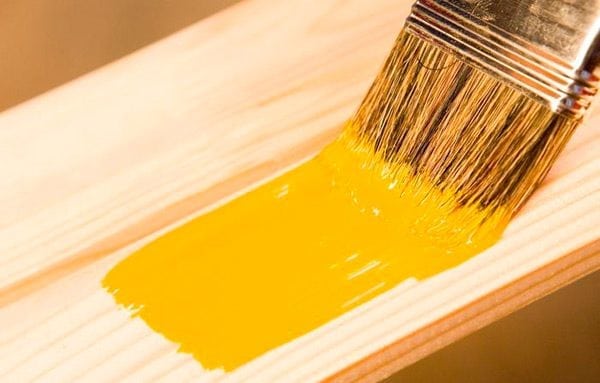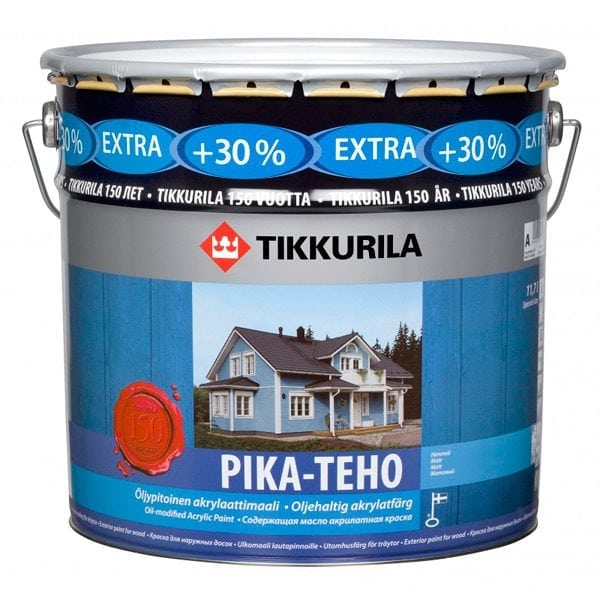Acrylic paint for wood is a material that is actively used in European countries to protect houses from logs and profiled timber, and to give them an aesthetic appearance. Often used for outdoor work, oil formulations are short-lived. Therefore, “acrylic” is the best option in the price / quality ratio.
Composition
Acrylic paints are the ideal solution for processing exterior wood surfaces. They belong to the group of water-dispersion. This means that the particles of the coloring pigment in their composition are in suspension.
Acrylates and polyurethane form the basis of the emulsion. After application to the surface, the water evaporates, forming an elastic, durable film. It penetrates shallowly into the structure of the tree.
An important feature of any composition based on acrylic, including paints for outdoor woodwork, is the size of the pigment. It is introduced into solutions in a highly ground form. Due to this, the composition is applied to the tree with a very thin, even layer. To choose the right shade, and they are issued a wide color palette, use a special computer program.

A special group of acrylic paints are flooring compositions from various types of wood. They are characterized by:
- high abrasion resistance;
- an opaque coating that completely conceals the wood texture;
- high adhesion with a wooden surface.
Important! With long-term storage, the mixture exfoliates. An emulsion remains on top, a coloring pigment settles at the bottom of the can. Stir the contents thoroughly before starting work!
Facade acrylic paints for wood must meet a number of serious requirements. This will help facilitate home care, reduce work time, extend the life of your home.
to contents ↑Specifications
The properties of the compositions for external and internal work are determined by various additives, providing high coating strength and its good elasticity. Such substances include:
- Plasticizers. They make the coating flexible. Therefore, acrylic paint on wooden surfaces does not crack even if there is some shrinkage of the latter.
- Hardeners. There are two types: hardeners themselves and driers. The latter accelerate hardening, but for acrylic paints are not mandatory additives in the composition.
- Matting substances. Gloss is removed, without them the surface glistens.
According to GOST, the front acrylic water-dispersion paint must meet the following indicators:
- Homogeneous, non-delaminating surface, without sagging and extraneous inclusions, obtained after complete drying.
- Non-volatile substances make up 52–74% of the total volume (the maximum value for the compositions on acrylic varnish and copolymers).
- The acid-base balance (pH) is in the range of 6.5–9.5.
- The maximum hiding power of the dried film (depending on color) is 100–120g / m2.
- Frost resistance - 5 cycles.
- Light fastness - no more than 5%.
- The film is resistant to moisture at an average temperature (at least 24 hours + 20 ° С).
- The degree of milling - 60 microns.
- The period of complete drying is 5-30 hours.
- The estimated service life of facade paint (depending on the external influences of the natural environment) is at least 10 years.
- The washout of the coating is 2–3.5 g / m2.
- The material consumption for a two-layer coating depends on the absorbency of the wood, as well as the degree of surface roughness. When using primer, less paint will be consumed.
- Good UV resistance.
Acrylic paint has become virtually the European standard. It is environmentally friendly, does not have an unpleasant poisonous smell, is vapor permeable (does not close the pores of the tree), and protects against moisture.
to contents ↑Criterias of choice
Making the right choice is quite difficult, given the rich assortment of modern supermarkets.
Advice! Take your time to go to the store. First, study all the important points, paying attention not only to the aesthetic side, but also to the practical one.
Acrylic paints are divided into 2 main categories:
- interior (for interior use);
- front (for external).

Compositions for outdoor use differ from interior compositions in their greater resistance to sunlight and various atmospheric influences. Typically, the facade is updated every 3-4 years. Therefore, do not buy super-expensive paint for outdoor work with a long service life.
Read more about this in the material devoted to wood facade paints.
If painted surfaces are not supposed to be washed regularly with a brush or sponge, do not choose compositions with a high rate of abrasion. This will save a little. If staining is done in the nursery or bedroom, give preference to hypoallergenic paints of the appropriate color.
Criteria for choosing formulations for coloring wood:
- Read the composition carefully. If it is long and incomprehensible, refuse to purchase. The classic composition of acrylic paint is filler (base), a binder (connects the components of the paint with each other, as well as with the surface), pigment coloring.
- Choose a product from a well-known manufacturer. If the inscription on the bank does not tell you anything, and the seller’s stories do not convince you, besides, he cannot show the certificate, refuse the purchase.
- Ask the seller what properties the selected sample has (maximum protection against moisture and mold, rodents and insects).
- Estimate the paint consumption per 1 m2.
- Evaluate the operational capabilities of future coverage.
- Check the cost and calculate the financial costs of paint work.
Manufacturers
Both domestic and imported paints are in demand. Thanks to modern equipment and foreign experience, Russian manufacturers do not lag behind foreign ones. Everyone has heard such brands as “Yaroslavl paints”, “Drevoplast”, “Aquatex”, “Extra”. In each company you can find compositions for both external and internal works, as well as a rich palette of shades.
Along with Russian, foreign manufacturers of facade paints are also popular:
- “Pinotex ultra” (Estonia);
- Belinka (Slovenia);
- “Tikkurila Pika-Teho” (Finland);
- Dulux (Great Britain);
- "DUFA" (Germany-Russia).
The most famous concern for the production of acrylic paints for exterior works is Tikkurila (Finland). Its products reliably protect wooden buildings from atmospheric precipitation, and also prevents the formation of mold and fungus. Tikkurila acrylic paint is very resistant to fading in the sun. Multiple tests have shown: it gives maximum surface protection thanks to a three-layer system, which includes an antiseptic primer.
DUFA is also well known in Russia.Such acrylic paints are made on modern equipment using the latest technology, meet all safety requirements, and have a wide color gamut.
Acrylic paints are a universal material. They are suitable for both outdoor and indoor use, for wood, glass, concrete and any other surfaces, including plastic. Among the minuses, it is worth noting only poor-quality production (typical for Chinese products) and violations in the application technology (the result does not meet expectations). Otherwise, nothing better has been invented than acrylic paints.








Hello! Where you are, leave a cell phone for contact - I will contact you.
I liked everything, except for "aging" - it is not in my taste ...
Good luck…))
Tikurila is just a paint with a not very pleasant smell and over time it cracks, and then it is necessary to grind the wood again. Tikkurila is not a good option for painting a wooden house.